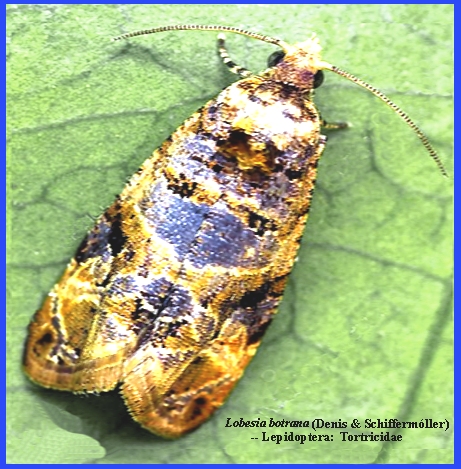File: <europeangrapevinemoth > Pooled References GENERAL
INDEX [Navigate to MAIN MENU ]
|
European Grapevine Moth Lobesia botrana (Denis & Schiffermüller) --
Lepidoptera: Tortricidae |
------ CLICK on photo to enlarge. To search
for Subject Matter, Depress Ctrl/F
----------------------------------------------------------------------------------------------------------------------------------
|
Adult
moth females may deposit 30-40 eggs per day for about 6 days. Hatching occurs from 3-11 days after
laying depending on the weather. The
larvae feed on their plant hosts for three to four weeks before they
mature. The pupal stage takes about
1-2 weeks before adults emerge. Adult
rarely live more than three weeks.
Several generations may occur in one growing season. The insect overwinters as pupae in cocoons
on the bark of grapevines or in soil crevices. Adults begin to emerge
from pupation when temperatures warm in springtime. REFERENCES:
FURTHER RELATED REFERENCES Coscollá,
Ramón R. 1998. Polillas del racimo (Lobesia botrana Den. y Shiff.). In: Los parásitos de la vid,
estrategias de proteccion razonada. Madrid, Spain. pp. 29–42. Del
Tío, R, J. L. J. L. Martínez, R. Ocete
& M. E. Ocete. 2001. Study of the relationship between sex
pheromone trap catches of Lobesia botrana
(Den. & Schiff.) (Lep., Tortricidae) and the accumulation of degree-days
in Sherry vineyards (SW of Spain). J. Appl. Entomol. 125: 9-14. Denis, J. N. C.
M. & Ignaz Schiffermüller.
1775. Systematisches
Verzeichniß der Schmetterlinge der Wienergegend herausgegeben von einigen
Lehrern. Theresianum. Wien 1775. Gabel, B &
V. Mocko. 1986. A functional simulation of European vine
moth Lobesia botrana Den. Et
Schiff. (Lep., Torticidae) population development. J. Appl. Entomol. 101:
121-127. Gallardo,
A, R. Ocete, M. A. López, L. Maistrello, F. Ortega, A. Semedo & F. J.
Soria. 2009. Forecasting the flight activity of Lobesia botrana (Denis &
Schiffermüller) (Lepidoptera, Torticidae) in Southwestern Spain. J. Appl. Entomol. 133: 626-632. Moreau,
J, & B. Thiéry Benrey. 2006.
Grape variety affects larval performance and also female reproductive
performance of the European grapevine moth Lobesia
botrana (Lepidoptera: Tortricidae). Bull. Entomol. Research 96:
205-212 Torres-Vila,
L. M, J. Stockel, R. Roehrich & M. C. Rodríguez-Molina. 1997. The relation between dispersal and
survival of Lobesia botrana
larvae and their density in vine inflorescences. Entomol. Exp. Appl. 84:
109-114. Zangheri,
S, G. Briolini, P. Cravedi, C. Duso C, F. Molinari & E. Pasqualini. 1992.
Lobesia botrana (Denis
& Schiffermüller). In: Lepidotteri dei fruttiferi e della vite.
Milan, Italy. pp. 85–88. El-Heneidy, A. H. & Fawzia A. Hawwanein. 1986. Meteorus gyrator Thunberg and M. rubens Nees. (Hymenoptera: Braconidae), new recorded parasitoids, on certain
lepidopterous pests in Egypt. Zeitschrift
angewandete Entomologie (1986). Hawwanein, Fawzia A. & A. H. El-Heneidy. 1988. Comparative study
of the parasitism by Microplitis
rufiventris Kok. (Hymenoptera: Braconidae) and Periboae orbate Wied. (Diptera:
Tachinidae) on main lepidopterous pests in vegetable crop fields in
Egypt. Bull. Soc. Ent. Egypte, Econ.
Ser. 17: 127-135. Hawwanein, Fawzia A.; A. H. El-Heneidy, M. S. Abbas
& A. R. Hamed. 1985. Survey of the parasitoids of main
lepidopterous pests in vegetable crop fields in Egypt. Bull.Soc. Ent. Egypte, 65:
259 -265. Honda, J. & S. V. Triapitzin. 1995a. A
species description and biological comparison between a new species of
Telenomus Haliday (Hymenoptera: Scelionidae) and Trichogramma platneri Nagarkatti (Hymenoptera:
Trichogrammatidae): two egg parasitoids of Sabulodes
aegrotata (Guene=E9) (Lepidoptera: Geometridae). Pan-Pacific Entomol. 71
(4): 227-236. Honda,
J. & S. V. Triapitzin. 1995b. A species description and biological
comparison between a new species of Telenomus Haliday (Hymenoptera:
Scelionidae) and Trichogramma platneri
Nagarkatti (Hymenoptera: Trichogrammatidae): two egg parasitoids of Sabulodes aegrotata (Lepidoptera: Geometridae). Pan-Pacific Entomologist 72 (3): 168-170. Triapitzin, S. V. & T. M. Tretiakova. 1997. Sexual behavior
of Apanteles oenone Nixon
(Hymenoptera, Braconidae), an exotic parasitoid of the pink bollworm, Pectinophora gossypiella (Saunders) (Lepidoptera, Gelechiidae). Russian
Entomological Journal 6 (1-2): 71-72. |
